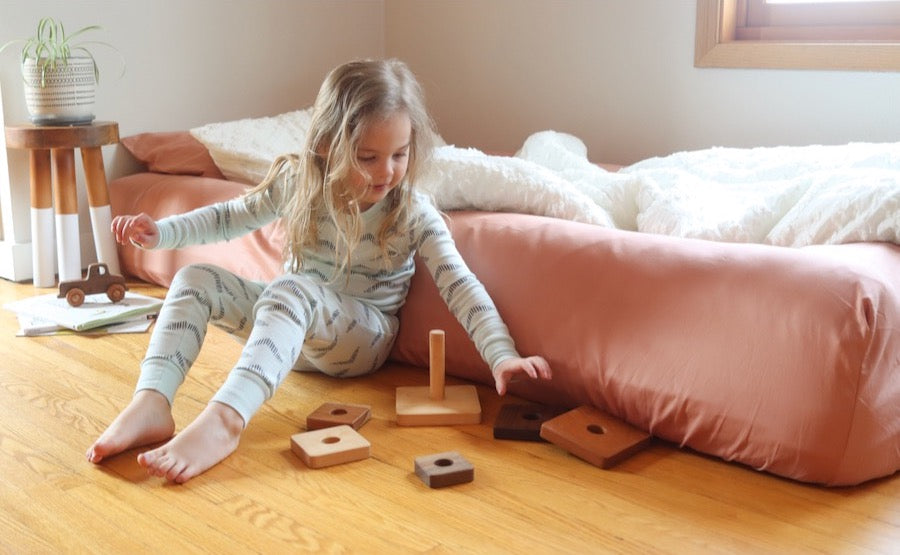Have you ever considered a floor bed for your young child?
As an alternative to cribs and “big kid beds,” floor beds allow young children the freedom to climb into and out of bed on their own. A floor bed is essentially just a mattress that rests directly on the floor, not on an elevated bed frame. As all parents know, “on the floor” is a wonderful height for anything you want your toddler to be able to reach easily!
Benefits of Floor Beds
Floor beds‘ accessible height promotes independence and a sense of self-efficacy — the feeling that a child has when they know they can do things effectively for themselves. Self-efficacy is important for all humans, and for our toddlers especially, as it helps them build confidence and awareness of their own capabilities.
Parents who like floor beds appreciate that they offer a child-centered, aesthetically pleasing, and cost-effective sleep option. Many parents who use floor beds describe feeling relief from worry, knowing their child won’t attempt to climb out of a crib and fall from crib height. Others appreciate the ease of snuggling their child at bedtime, something that can be tricky in a big-kid bed or impossible with a crib.
Floor Beds + Oolie
At Oolie, we love floor beds, and we designed the Oolie Base to enhance the developmental support that floor beds provide. The Oolie Base secures bolsters in place along the edges of the mattress. But the Oolie Base and Bolsters are not bed rails, and aren't intended to keep your child “trapped” in the bed. But why not?
As toddlers grow, one of their many developmental tasks is honing their body position awareness. Part of learning how to move through the world and enact change on the world is internalizing a sense of where your body is (and isn’t) in relationship to other people and things.
Eventually, some of this positional awareness is maintained even during sleep. Notice how older children (and adults) don't fall out of bed during the night: even while asleep, they have an internalized sense of where their body is, relative to the edges of the mattress.
Until that positional awareness kicks in, we parents see a lot of... midnight wake-ups and crying toddlers, due to rolling out of bed! (Or, worse, injuries from falling out of an elevated bed frame!)
Some parents keep their children in cribs as long as possible, in an effort to postpone this transition. Other parents will employ bed rails to prevent falls.
When we designed the Oolie Base, we were less concerned about falls because, well, floor beds are already on the floor. But we still wanted to prevent nighttime head bonks and accidental roll-offs.
So the Oolie Base and Bolsters are not designed to ”keep your kid in“ so much as to promote and enhance awareness of the edge of the bed, using visual and tactile cues. The nighttime “nudges” from the bolsters encourage your little one to stay on the mattress while developing that essential positional awareness.
That the Base and Bolsters are super cozy and snuggly is just a bonus!
Safety First
All of that said, before you decide whether a floor bed is right for you and your little one, consider safety, first and foremost.
Childproofing
Thoroughly childproof any room before using a floor bed. Once your child can choose to get out of bed, they will be able to go wherever they please — unsupervised, and in the dark, at night! — and explore whatever they find. This means anchoring furniture (like dressers and bookcases) to walls, so they can’t tip over. It means outlet covers on every socket, and toddler-safe cords on window treatments to eliminate any risk of strangulation.
Make sure your childproofing extends to anywhere in the house your child could access on their own, once out of bed. For example, if they could climb out of bed, then open their own bedroom door... Is there a hallway? (Cover outlets, check for other hazards.) A staircase? (Close and lock your safety gate at the top of the stairs.)
Sleep Hazards
Consider potential sleep hazards like entrapment. Are there any gaps that your child could become stuck in? Many pediatricians, including Dr. Whitney Casares (@modernmommydoc), recommend moving floor beds away from walls to reduce the risk of your child getting stuck between the wall and the mattress.
Infant Sleep
Floor beds are most commonly used with toddlers, once the child is mobile enough to climb up onto their own mattress.
For children under the age of 1:
-
Talk with your medical provider about the safest way for your child to sleep
-
Consider the safe sleep recommendations of the American Academy of Pediatrics
-
Note that the Oolie Base is not intended for use with infants. The bolsters are a suffocation hazard for this age range.
Oolie does not provide medical advice. We believe families should make their own informed decisions about sleep in consultation with their health care providers, sleep experts, and other trusted sources of knowledge.
—Ama Liebke
Photo by Brittany Mathiowetz


